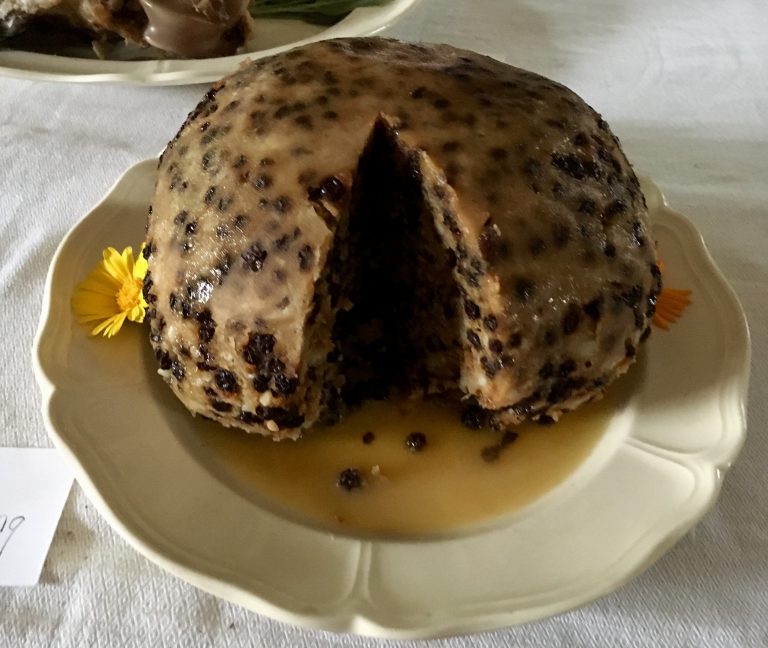Learn about this recipe from our historic foodways staff, then try it at home
From A Christmas Carol in Prose, Being a Ghost-Story of Christmas, by Charles Dickens, 1843.
Mrs. Cratchit left the room alone — too nervous to bear witnesses — to take the pudding up and bring it in…Hallo. A great deal of steam. The pudding was out of the copper. A smell like a washing-day. That was the cloth. A smell like an eating-house and a pastry cook’s next door to each other, with a laundress’s next door to that. That was the pudding. In half a minute Mrs. Cratchit entered — flushed, but smiling proudly — with the pudding, like a speckled cannon-ball, so hard and firm, blazing in half of half-a-quartern of ignited brandy, and bedight with Christmas holly stuck into the top.
It is this passage from Dicken’s famous story that help cement the plum pudding as the crowning glory of all holiday treats. Though the story was written in the 19thy century, plum puddings, or plum pottages, has a long history with roots as far back as the 15th century. Like their counterpart mincemeat pies, the first plum puddings contained meat. Today the last vestiges of that particular ingredient can be found in the addition of beef suet. In their original form they were made of a variety of chopped meats, usually mutton or beef, with vegetables and fruits. Its liquid consistency allowed the pudding to be boiled in a cloth, to create a firm and filling pudding. Eventually the vegetables fell away, but the fruits remained. Plums came to mean any type of dried fruit, though traditionally they stared as prunes, to raisins and currants. The new style of steaming the pudding, instead of boiling, began in the 19th century and remains with us today. We hope you will try our very traditional pudding at your holiday gathering. And as always, we wish you all the happiest and healthiest of season.
18th Century
Take a pound of suet cut in little pieces, not too fine, a pound of currants, and a pound of raisins stoned, eight eggs, half of the whites, the crumb of a penny-loaf grated fine, half a nutmeg grated, and a teaspoonful of beaten ginger, a little salt, a pound of flour, a pint of milk; beat the eggs first, then half the milk, beat them together, and by degrees stir in the flour and the bread together, then the suet, spice, and fruit, and as much milk as will mix it all well together and very thick; boil it five hours.
— Hannah Glasse’s Art of Cookery Made Plain and Easy, 1747 ed.
21st Century
Ingredients
- ½ pound suet, chopped
- ½ pound of currants
- ½ pound of raisins
- 4 eggs, minus two whites
- 1 small roll grated into breadcrumbs
- 1tsp grated nutmeg
- 1 tsp grated ginger
- ½ pound of flour
- Pinch of salt
- 1 cup of milk
- Sauce:
- ¾ cup sherry or brandy, ½ cup sugar, ¼ cup butter
Instructions
- Fill a stockpot about 2/3 full and bring to a boil. Have a teakettle or another pot of water heated as a reserve.
- Whisk eggs until frothy. Add half the milk.
- Gradually add the flour, and breadcrumbs.
- Incorporate the suet, spices, and fruit. Gradually add remaining milk as needed to make a very thick batter. Insert a wooden spoon in the middle of the bowl. It should stand straight up.
- Prepare your pudding cloth: Take a tightly woven linen cloth, about 24 x24 and lay it on the table. Take some softened (not melted) butter and spread a thin layer of butter all over it. DO NOT MISS ANY AREAS. Next, sprinkle a layer of flour on top of the butter layer. Over the sink, trash can, or outside, draw up the corners of the cloth and shake the flour around the cloth to ensure it is completely coated.
- Lay the cloth on the counter, or inside a bowl. Carefully spoon the pudding batter on to the center of the cloth. Draw of the sides of the cloth and twist tightly so that your pudding looks like a ball. Tie it closed with cooking twine, making sure it is a tight as possible, leaving some twine to hang the pudding.
- Take a long wooden spoon and slide the twine loops on to it. When the water has come to a full boil, lay the spoon across the top of the pot. The pudding should be completely immersed in the water, but not touching the bottom. Boil for about two and a half hours, topping off the pot with boiling water as needed. It is very important to keep the water boiling at all times to prevent the pudding from becoming water-logged.
- To check the pudding, remove from the water and let set in a colander for a few minutes. Tap the pudding. It should feel slightly firm, not squishy. If it is finished. Let it cool a little while longer, then carefully untie the cloth and slowly peel it away from what will be the bottom of the pudding. The cloth should not stick. Take a plate and turn the pudding right side up. Carefully remove the remaining cloth from the pudding.
- In a small saucepan, add the alcohol, sugar and butter, heat on low until sugar is completely dissolved and the sauce thickens a little. Pour over the pudding and enjoy.
